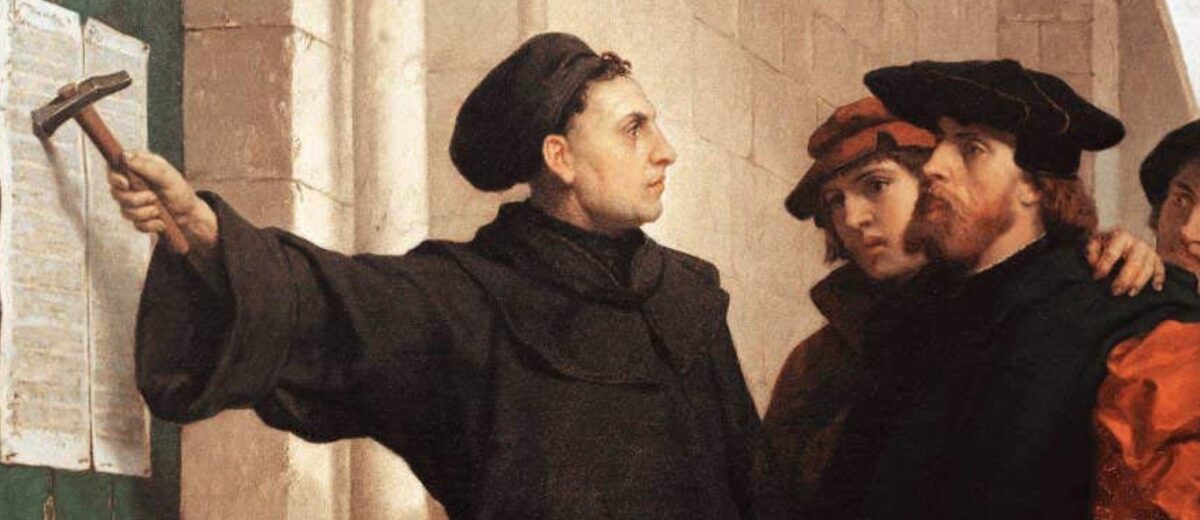The story of Martin Luther hammering his 95 theses on the Wittenberg Door – as I referred to last week – is an unconstructive myth. It promotes a wrong picture of the monk as a rebel and is unhelpful for the cause of reconciliation and unity between Protestants & Catholics.
This was the thoughtful response by a reader of my last weekly word about how Halloween triggered the start of the Reformation. Luther himself had never mentioned posting the theses on the door in all his writings, he affirmed, and there was no direct historical evidence that they had ever been posted in this way.
The reader, Thomas Cogdell, set out to gather all the major streams of Jesus-followers in Wittenberg on the 500th anniversary of the Reformation. This initiative called Wittenberg 2017 involved Catholics, Protestants and Messianic Jews, clergy and laity, meeting both to celebrate the gifts of the Reformation and to grieve over the divisions in the Body of Christ.
The well-known picture of Luther with hammer in hand (above) which helped popularise this myth was produced by Ferdinand Pauwels in 1872 during the Kulturkampf, the bitter struggle (c. 1871–87) on the part of the German chancellor Otto von Bismarck to subject the Roman Catholic church to state controls.
The posting of the Theses was an unhelpful legend, the group concluded, because it reinforced a wrong picture of Luther in 1517. He was not a rebel at that time but a pious monk obeying his bishop and sending him the 95 Theses for further discussion — not knowing that the pope and the archbishop of Mainz were deeply involved in the trade of indulgences.
Thomas wrote: ‘The image gives Catholics permission to declare Luther as a rebel intending to divide the church, and gives Protestants permission to “post their own theses” wherever they want to, e.g. on social media.’
Prophet
In the first of their published conclusions, the group honoured Martin Luther as ‘a prophet sent by God to Luther’s own church, the Roman Catholic Church’ which at the time was in great need of reform. ‘The church was filled with moral failings, political power struggles, and manipulations for financial gain. Beginning more than a century before Luther, God sent prophets calling for reform. Sadly, church authorities killed or attempted to silence these men by other means. These prophetic voices included the Waldensians, Wycliffe, Hus, Savonarola … and then Martin Luther.’
In 1517, the researchers affirmed, Martin Luther was a loyal Catholic, an obedient Augustinian monk and a teacher in the Wittenberg University. He was not a rebel trying to start a new church separate from the Roman Catholic Church. Luther sent the 95 Theses to his Archbishop, Albrecht of Mainz, in accordance with the New Testament model of prophets submitting prophetic messages for testing by apostolic authority. Luther expected to initiate an internal church discussion, as well as an academic debate regarding the validity of the points raised in the 95 Theses.
The group’s second conclusion was that Luther’s prophetic message was not correctly considered or responded to by his apostolic authorities. Both the archbishop and the pope were caught in positions of compromise. The sale of indulgences was helping Albrecht to repay his debt to the Fugger bank incurred by the purchase of his bishopric. Pope Leo X was the one who had authorized the indulgences in Germany, in the expectation of receiving half the revenue for the renovation of St. Peter’s Basilica. To receive the prophetic word from a lowly monk in Germany would have been to face the loss of funding for his ambitious building project. Instead, he first tried to silence Luther through channels of church authority, and eventually issued a papal bull for Luther’s excommunication.
Unity
Thirdly, the group grieved ‘the subsequent shared history of hostility’ in which the Roman Catholic Church excommunicated Martin Luther, while Luther called the pope “Anti-Christ,” spoke about killing bishops and clergy as equivalent to killing enemies in a war. The Protestant/Catholic split led directly to the Thirty Years’ War, which eventually killed around one-third of the population of Europe. Both Protestants and Catholics persecuted proponents of the Radical Reformation – Anabaptists, Pietists, Quakers, and other movements that advocated separating the church from the power structures of states and nations. Another area of “unity in hostility” has been anti-Semitism, while the Protestant legacy has been one of further and further splintering.
Wittenberg 2017 aimed then to encourage repentance, forgiveness, reconcilaition and joint celebration and prayer for unity in the Body of Christ ‘in preparation for Jesus’ return’.
Thomas’ own marriage is a story of his journey towards reconciliation. He is Protestant, his wife Catholic, and together they have written Unity through Repentance, The Journey to Wittenberg 2017 (William Carey Publishing). Part of the journey involves clearing the obstacles towards travelling together – including unconstructive myths such as that of a hammer-wielding Luther.
Till next week,



